
|   |

|   |
 e-mail: leelakaverivenkat@gmail.com Parampara Festival features changing face of inheritance in dance Photos courtesy: Natya Tarangini November 23, 2022 A Pariwar Parampara, at least over two generations, the Reddy family of Raja, Radha and Kaushalya, have diligently passed on the Kuchipudi heritage to daughters Yamini and Bhavana, at a time when children taking to the parents' profession, particularly in dance, is not very common. The annual Parampara Festival conducted by the Reddys in the open-air auditorium, so thoughtfully constructed as part of their residence cum school in Delhi's Saket, has been featuring annually through this festival, the contemporary face of various dance forms, which trace their birth to a deep past. 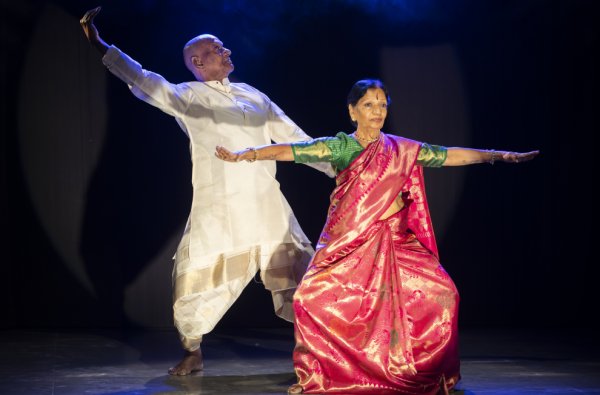 Drs. Raja and Radha Reddy Following their established convention of the hosts being curtain raisers for the festival, the Reddys this time, using minimal text, had fashioned a whole recital, the concept having originated from daughter Yamini. Dedicated to Lord Venkateshwara, the presiding deity of Andhra, the home of Kuchipudi, the recital was fashioned round the idea of dance as a search for the supreme consciousness, transcending time and space, where even abstract dance in the shape of pure nritta, can lead to an elevated space in the consciousness, depending on the total involvement, with complete negation of self-identity of the dancer. Thus tam tat thei, and tai hit tat tam thai represent sacred syllables signifying the Jeevatma/Paramatma union. Pandu Ranga Rao's book on Venkateshwara was particularly mentioned as the inspirational point, when Kuchipudi dance got enthused to take up, through auditory and visual meditation, themes connected with this deity. Esotericism of Tantra carries geometry of lines to its finest point (the dot or full stop as the Bindu, the triangle, both inverted and upright, the circle and square, and the hexagon representing cosmic union Evam) comprising sacred shapes and mathematical designs believed to lie behind all creation, representing several qualities and interconnections of life. Body formations in yoga and dance are also inspired by this geometry. Yamini Reddy along with three other arresting dancers, Prakriti Prashant, Noor Kaur Chopra and Pernia Qureshi, all comely performers combined with grace and precision in what was choreographed by Raja Reddy, portraying attitudes and qualities of the God based on hymns dedicated to Venkateshwara. The highlight of the evening was the scene from the Kurukshetra battlefield, of Krishna delivering the Gitopadesam, convincing Arjuna of his dharma, featuring the veteran couple Raja and Radha Reddy as Krishna and Arjuna respectively. Entering the field in his chariot driven by Krishna himself, Arjuna pales on seeing all his close relatives and friends against whom he would have to wage war. "Na kangshe vijayam Krishna, nacha vijayam sukhanica" I want no victory or kingdom, he says. "Seedanti mama gatrani mukham cha parishushyati, vepatancha sharire me romaharsha jayate, Gaandeevam triyamsate hastaatvakchaiva" (body hair standing on end, dry mouthed, even the bow slips from the hands). The dignity of a streamlined Raja Reddy apart, in portraying Arjuna's renewed strength of conviction after being treated to Krishna's sermon, the mimetic skills and agility of Radha Reddy with her bearing and footwork, made one feel that she is growing younger with the years. As for the music set to ragamalika with each sloka sung in a different raga, ushering in mood changes, in Poorvadhanashri, Behag, Darbari, Todi, Durga, Hamsadhwani and Sindhu Bhairavi, this was an extremely well planned production. 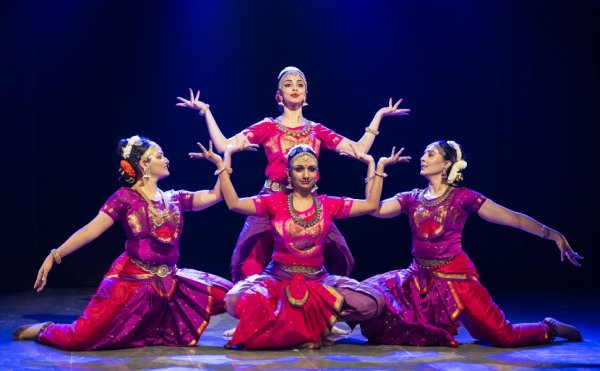 Natya Tarangini ensemble The Tarangam in Arabhi Manikkagunasheela dayala with the four competent dancers dancing on the rim of a brass plate (which represents leaving earth, journeying off into a higher consciousness, according to Raja) concluded the recital. The competent wing support of accompanists was led by Kaushalya Reddy providing the nattuvangam lead, Deevi Ravikant and Lavanya Sundaram lending vocal support, Mamillapalli Chandrakanth on mridangam and V.S.K. Annadorai on violin, Kiran Kumar on flute. 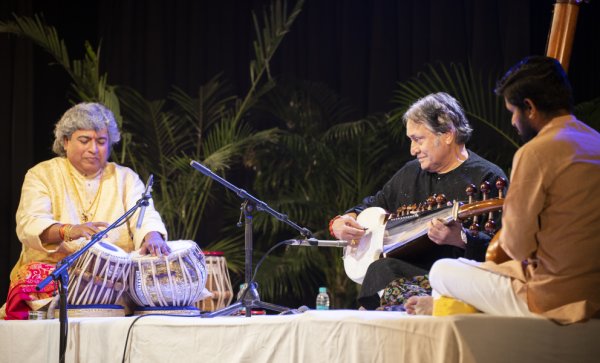 Ustad Amjad Ali Khan The music which followed with maestro Ustad Amjad Ali Khan on the sarod playing Alaap, Jod in Jhinjhoti and Durga turned out to be both a melodic treat along with the tala virtuosity of 6 1/2 matras with Ramkumar Mishra's mellow and extremely tuneful tabla accompaniment - a musical experience to be treasured! Next evening, Rama Vaidyanathan's Bharatanatyam, with a surprisingly smaller audience than she always attracts, began on a note, in keeping with her experiments in trying to reach out to larger audiences, expanding the repertoire of a dance form through compositions, which while carrying forward the classical verities of the dance, experiment with languages outside the regional soil of the dance form. The base work was by singer Sudha Raghuraman, who using Hindi sahitya "Jhuk ayi badariya saavan ki, Saavan ki man bhaavan ki" set it in the typical format of a varnam. The ragas were all connected with nature, for here the heroine's thoughts of love are spurred by the moving clouds and the pitter patter of rain (Nanne nanne Boondahe megha barase). Starting with raag Jog, the next line is set to Varuna Kriya, rare sampoorna Carnatic raga. Then comes Megh Malhar, Basant as nature blooms in all her colours and as month of Saawan comes in, the music is set to Desh. Truly taking off in crying form, on wings of music, with the mimetic portions punctuated by tight teermanams set by late Shiva Kumar, Rama was in true form. The low draping of the saree pallav in front, (an exaggerated late Rukmini Devi style), was a new touch by the dancer herself and more comfortable. 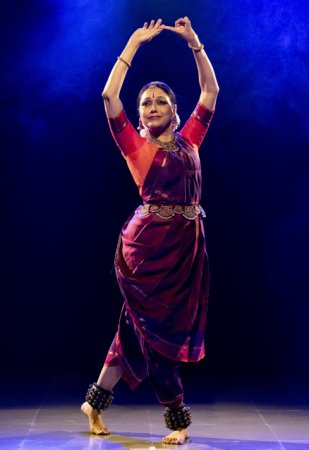 Rama Vaidyanathan The Annamacharya composition for which the dancer was commissioned some months ago by Ananda Shankar Jayant for the Tamrapatra series, Sati ninnu gelichenu, set to music in ragam Karnaranjini by late Venu Madhav, was chosen for interpretation in the recital. According to this critic, the treatment was slightly off beat, and different from one's perceptions of this lyric. Rama's interpretation, imagining a setting, post difference of opinion between the divine couple Alamelumanga and Venkateshwara, in the choreography, stressed on Alamelumanga's superior skills in the art of making love - vanquishing Venkateshwara. There was an obvious lokadharmic tilt (very much in the dancer's individualistic style) to movements expressing Venkateshwara losing in the game of love. Viewed from a more elevated level, the poet here, as one would choose to interpret, is actually full of admiration for Alamelumanga for having won over the heart of Venkateshwara (who is after all the presiding deity of love) so completely. Even Cupid's arrow is known to miss its mark occasionally - but not one look from Alamelumanga's eyes directed at Lord Venkateshwara– which is enough to send him scurrying to her side. 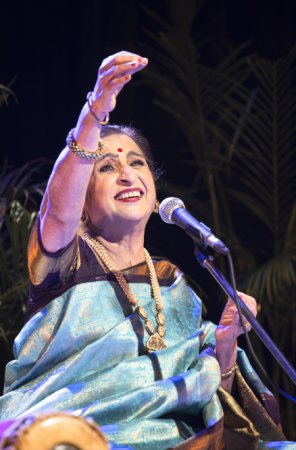 Aruna Sairam The second half of the evening featured a Carnatic vocal recital by Aruna Sairam, who turned the occasion through her introductions, into an educating experience for the audience, along with the pleasure of listening to music. Suiting the salubrious space for art built by the Reddys with so much imagination, she started with the Abhogi composition of Gopala Krishna Bharti Sabhapattikku veru deivam Samaanamaagumaa and also narrated the connected episode with the song when the singer went to meet Tyagaraja. Next came verses on the Devi from the Lalita Sahasranamam "Sindhooraruna vigrahaam, Trinayanaam..." followed by Muthuswamy Dikshitar's composition in Amritavarshini, Anandamrita karshini Amritavarshini. Abhang for which the artiste is famous came next "Jyaca Sikha Hari Visnu kripa kare" along with a brief introduction to Namadev and how even the maid Janabai became a great devotee. Purandara Dasa's Kannada song "Ragi tandeera, Bhikshake ragi tandeera" was introduced with its philosophy of how living on bhiksha or alms only, as a self-chosen discipline in striving for self-realization, is practiced. Talking of simple songs like Oothukadu Venkata Subbaiyer's "Maadu meikkum kanne, Poga vendaam sonne" the singer explained how , rendered by one and all such compositions become part of a shared common culture. Aruna Sairam concluded with her piece de resistance, Oothukadu Venkata Subbaiyer's Kalinga Nartana Tillana in Nattai, its infectious rhythm holding the audience in spell. The final day's program was cancelled due to unavoidable reasons as announced.  Writing on the dance scene for the last forty years, Leela Venkataraman's incisive comments on performances of all dance forms, participation in dance discussions both in India and abroad, and as a regular contributor to Hindu Friday Review, journals like Sruti and Nartanam, makes her voice respected for its balanced critiquing. She is the author of several books like Indian Classical dance: Tradition in Transition, Classical Dance in India and Indian Classical dance: The Renaissance and Beyond. Post your comments Pl provide your name and email id along with your comment. All appropriate comments posted with name and email id in the blog will also be featured in the site. |